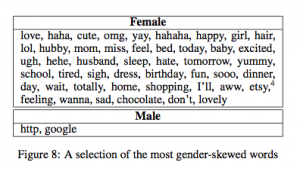Because the tech-support people I need to talk to in order to straighten out a data analysis snafu are in Germany, creating temporal challenges, I’ve been catching up on reading. As a result, I had just read Carol Rose’s 1998 piece The Several Futures of Property: Of Cyberspace and Folk Tales, Emission Trades and Ecosystems when an email came in from SumofUs.org with a petition against Nestlé’s attempt to patent the medicinal use of the fennel flower.
A few days before that, the monthly UC Berkeley newsletter had a story about scientists who were launching a drug company based on producing an antimalarial chemical synthetically in yeast instead of in its plants of origin. I was already familiar with the malaria example because my friend Josh Kellogg, who’s an ethnopharmacologist, was working on malaria treatments from natural sources as his PhD project until the money dried up in favor of synthetics—which, he pointed out to me, ultimately derive from knowledge of plant sources anyway (as in the Berkeley research case).
Perfect storm weeks like this get me thinking and make me want to work through connections, so that’s what I want to do here. I’ve written before about privatizing fandom and enclosing the commons, but Rose’s piece gave me a new angle on the commons that I think is useful for the work I’m doing on fandom in my dissertation—that of capitalist disrespect and appropriation of indigenous intellectual property.
Now, this is mine-filled territory, because it risks evoking the logic of pure, uncorrupted-by-civilization (and thus implicitly uncivilized) indigeneity I critiqued in The Trouble with Tribals. So, to be clear, the idea of indigenous intellectual property is being used here to think with, to structurally or metaphorically denote a group with a different set of values than the dominant ones of capital and a different set of beliefs about ownership and individual creativity, which are devalued by the dominant both because of these different values and for other reasons (racism in the literal-indigeneity case and sexism/devaluation of emotion in the fan case).
The connection of intellectual property concerns to indigenous people is not novel—Rose herself notes that in the forms of property she discusses “both factors—unconventional communal claims and unrecognized social status—overlap and conspire against property recognition. Historically, this was perhaps most noticeable in European encounters with Native Americans” (p. 141). What I want to do here is work through what this looks like for fandom alongside this Nestlé case to see what this renders visible.
First, what we see in the Nestlé patent of longstanding knowledge and industry efforts to monetize fandom is that things known or produced by certain groups don’t count as owned by them.
On one hand, this is because the claims to property often don’t take recognizable shapes in these cases—as Rose puts it, they “do not look like property at all to us” (p. 140). Rose’s piece traces out a theory of a property format called “limited common property,” which is “property on the outside, commons on the inside” (p. 144). That is, it’s not a pure commons, because not everybody is eligible to exploit it, but those who are on the inside can make use of it as completely as is allowed within the norms of the community.
This, to me, looks a lot like fandom: everybody in the community has shared access to everybody else’s stories, vids, meta, etc., but—in part due to stigma—there’s a protective attitude in relation to outsiders. It’s also like the fennel flower case: “everybody knows” the value of the plant, but that doesn’t make it a free-for-all for capital.
Related to this, which Rose raises but doesn’t really delve into, is “questions of alienability” (p. 140); limited common property isn’t very alienable because, unlike standard property, no one person owns it, such that nobody can really sell it off, and particularly not for individual gain.
This, I think, is part of why “pulling to publish”—the practice of converting fan fiction into novels like 50 Shades of Gray by renaming the characters (and then deleting the original)—is often frowned upon in fan communities. Yes, a person wrote it, but they generally did so in a community. And indefinable but vital contributions arise from interaction with those community members, such that then denying them access is denying recognition for their labor in favor of the single creative figure of the author.
This isn’t necessarily nefarious (although it can be). Mostly I’d attribute it to the fact that “the author principle is easy”: “it is easier to identify a single author (or definite set of authors) than an amorphous group, like a ‘village’; it is easier to identify a sharply unusual intellectual product than one that builds incrementally on the ideas of others, like a folktale; it is easier to mark out a product of sudden innovation than a gradual modification of nature, like a village’s long-cultivated plant product” (Rose p. 152).
This is also what makes Nestlé’s grab make sense (from an intellectual property standpoint, though clearly not a moral one). The SumofUs email noted that “in a paper published last year, Nestlé scientists claimed to ‘discover’ what much of the world has known for millennia: that nigella sativa extract could be used for ‘nutritional interventions in humans with food allergy’.”
This claim to discovery works because the knowledge is common across “much of the world” and no one really owns it, so Nestlé sees an opening to claim ownership. The problem with this is alienability. “Nestlé is attempting to create a nigella sativa monopoly and gain the ability to sue anyone using it without Nestlé’s permission” (SumofUs); nobody owns it, but it’s because everybody owns it.
As Rose notes, “the extension of the author or inventor principle privileges the contributions of the industrialized West over those of non-Western cultures, among other matters by rejecting intellectual property status of folklore or for carefully cultivated plant products from third-world agrarian groups” (p. 151).
In this case, it’s even more absurd than usual, since Nestlé wasn’t even the first to translate this communal knowledge into the language of science—“researchers in developing nations such as Egypt and Pakistan had already published studies on the same curative powers Nestlé is claiming as its own” (SumofUs). But then, it may well be that those scientists don’t “count” in the same way as a multinational corporation.
This idea of limited common property is useful because it explains how people can seemingly share things freely and at the same time have a right not to have that appropriated by capital. But because these are nonstandard kinds of claims about property, based in nonstandard, more communal and less individualistic value systems, made by less-valued people, running over that right to not be appropriated is startlingly easy.

















